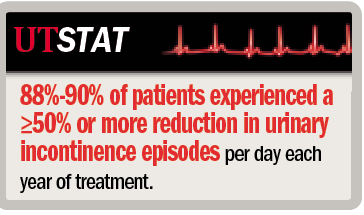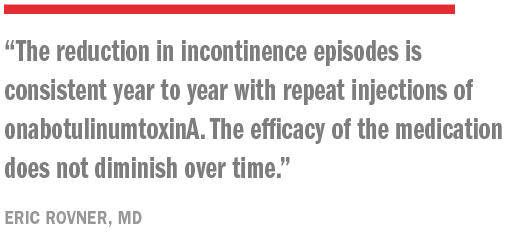Article
Botulinum efficacious long term for neurogenic bladder
Author(s):
OnabotulinumtoxinA (Botox) appears to offer long-term benefits in patients with neurogenic detrusor overactivity, recent study results indicate.
Charleston, SC-OnabotulinumtoxinA (Botox) appears to offer long-term benefits in patients with neurogenic detrusor overactivity, recent study results indicate.
Recommended: PTNS efficacy bolstered by adjunctive pharmacotherapy

Previous studies have demonstrated botulinum’s safety and efficacy in patients with neurogenic detrusor overactivity, explained first author Eric Rovner, MD, professor of urology at the Medical University of South Carolina, Charleston. For the current study, which was presented at the AUA annual meeting in New Orleans, Dr. Rovner and colleagues sought to assess long-term outcomes in patients who underwent botulinum treatment for 4 years.
All the patients had urinary incontinence, and all had failed oral drug therapy. Average patient age was about 45 years, and nearly half (45.1%) of the patients were male. At baseline, patients experienced an average of 4.3 urinary incontinence episodes per day, and 71% required clean intermittent catheterization.
Patients had participated in one of two large randomized double-blind placebo-controlled trials evaluating botulinum in doses of 200 U or 300 U that lasted for 1 year. At the conclusion of that study, patients then entered a 3-year extension study. Patients who started on the 300-U dose were switched to 200 U following FDA approval of botulinum, 200 U for treatment of urinary detrusor overactivity.
Also see: Can a patient’s foot help their OAB symptoms?
Patients received up to two treatments in year 1, and then multiple treatments in the 3-year extension phase provided “as needed” for symptom control based on pre-specified retreatment criteria: patient initiation of a request for retreatment, minimum of 12 weeks since previous treatment, and one or more urinary incontinence episodes within 3 days.
Outcomes assessed included change from baseline in number of daily urinary incontinence episodes, proportion of patients with ≥50% and 100% reduction in daily urinary incontinence episodes, overall median duration of effect, rate of adverse events, and initiation of de novo clean intermittent catheterization.
NEXT: Consistent reduction in incontinence seen
Consistent reduction in incontinence seen
The authors found a consistent reduction in mean number of urinary incontinence episodes per day of –3.4, –3.6, –3.8, and –3.7, over years 1 to 4, respectively. The overall median duration of effect was more than 9 months. In addition, 88%-90% of patients experienced a ≥50% or more reduction in urinary incontinence episodes per day each year of treatment, and 44%-52% of patients reported a 100% reduction in urinary incontinence episodes per day each year of treatment.
Read: Many SUI studies lack long-term follow-up

“The reduction in incontinence episodes is consistent year to year with repeat injections of onabotulinumtoxinA. The efficacy of the medication does not diminish over time,” Dr. Rovner said.
Adverse events that occurred in ≥5% of patients consisted of urinary retention and urinary tract infection, although the incidence of each had declined by the end of the 4-year period. De novo clean intermittent catheterization rates over years 1 to 4 were 39.1%, 10.7%, 8.0%, and 0.0%, respectively.
“There were no new safety signals over time,” Dr. Rovner said.
Dr. Rovner is a consultant/adviser and meeting participant/lecturer for Allergan. Several of his co-authors have similar roles with Allergan and/or are employees of or investors in the company.
Have you read:
Greater risk of re-operation with TOT vs. TVT
Neuromodulation adverse events characterized
Serious sling complications may be under-reported
Subscribe to Urology Times to get monthly news from the leading news source for urologists.

















